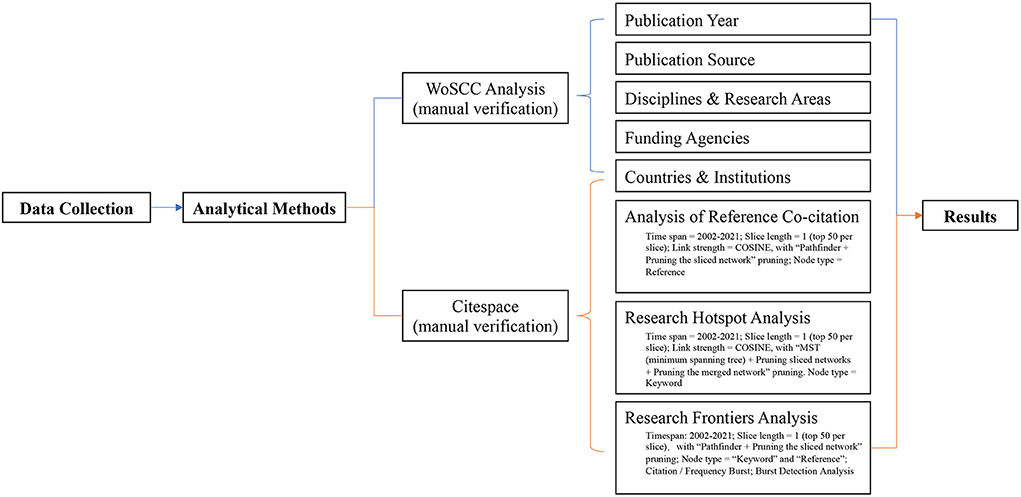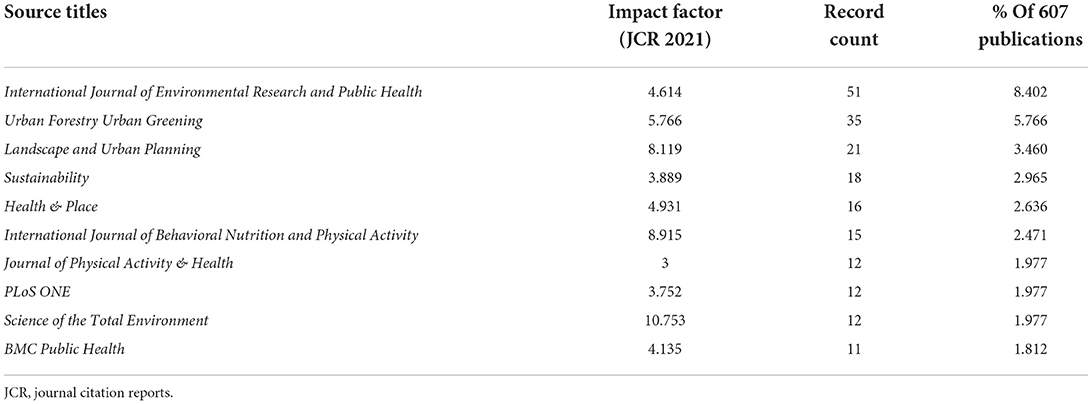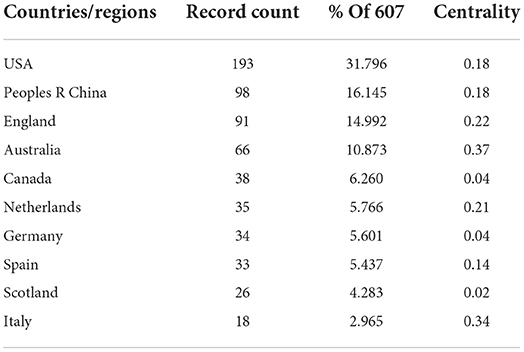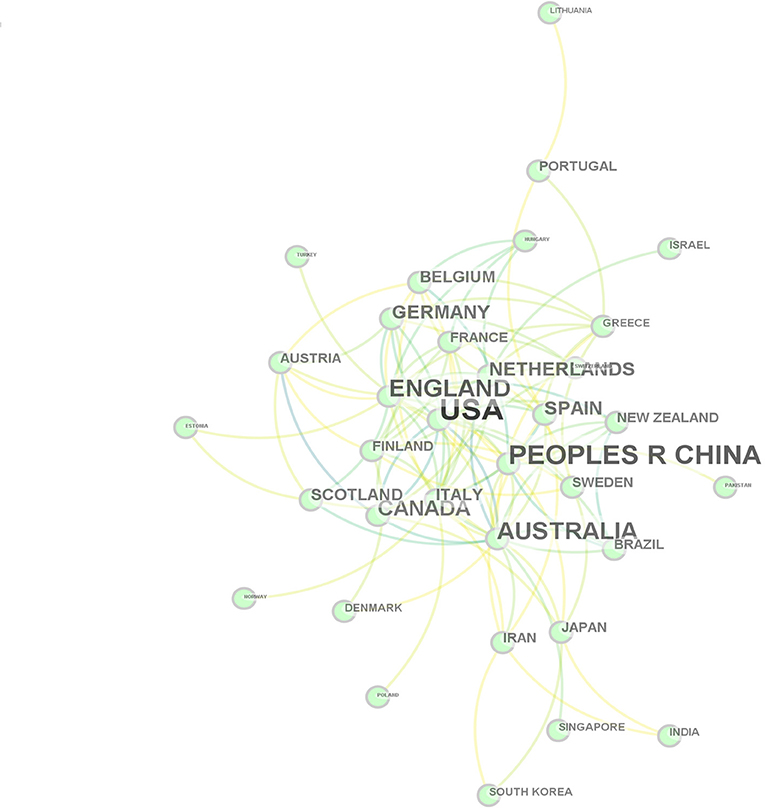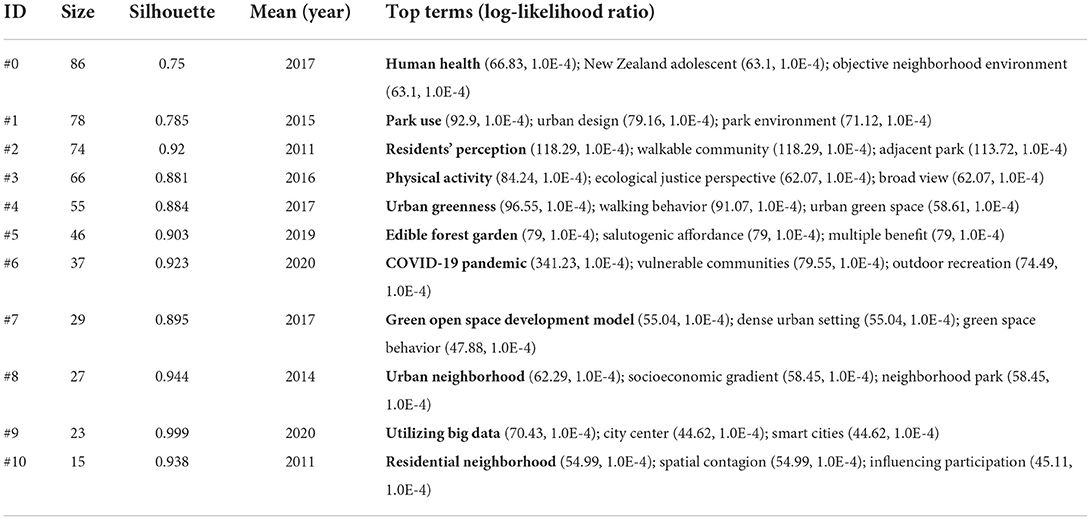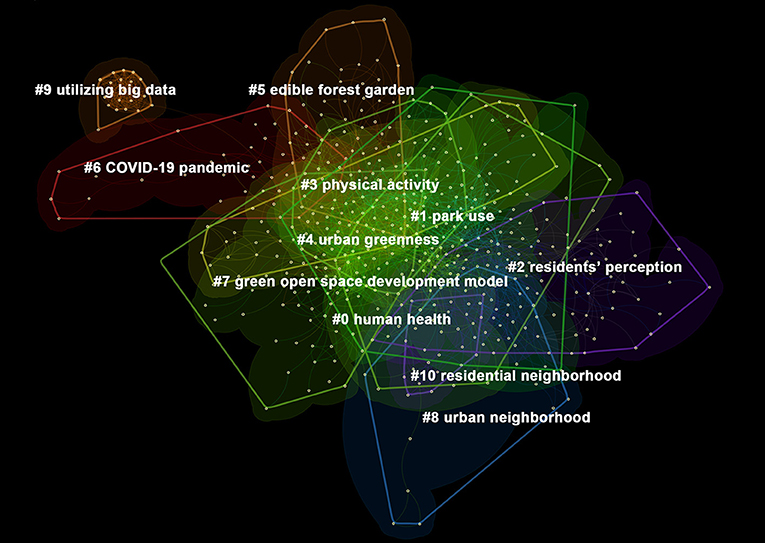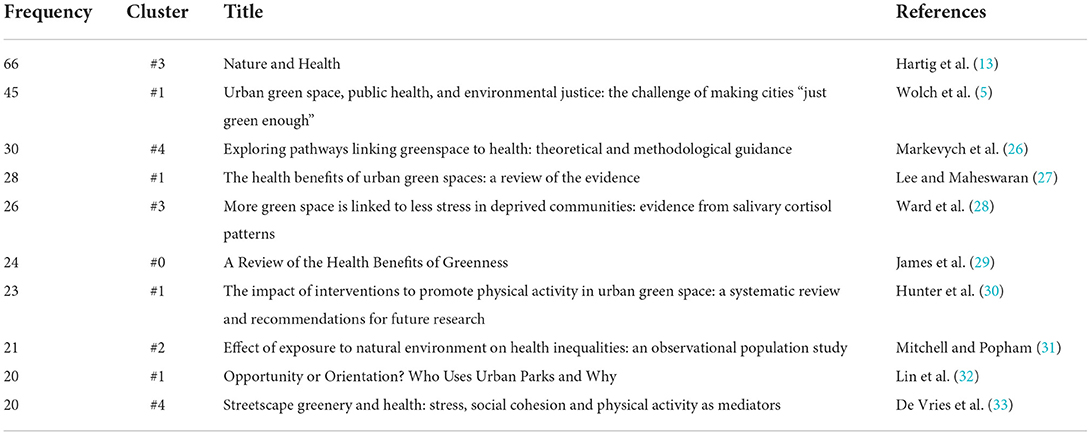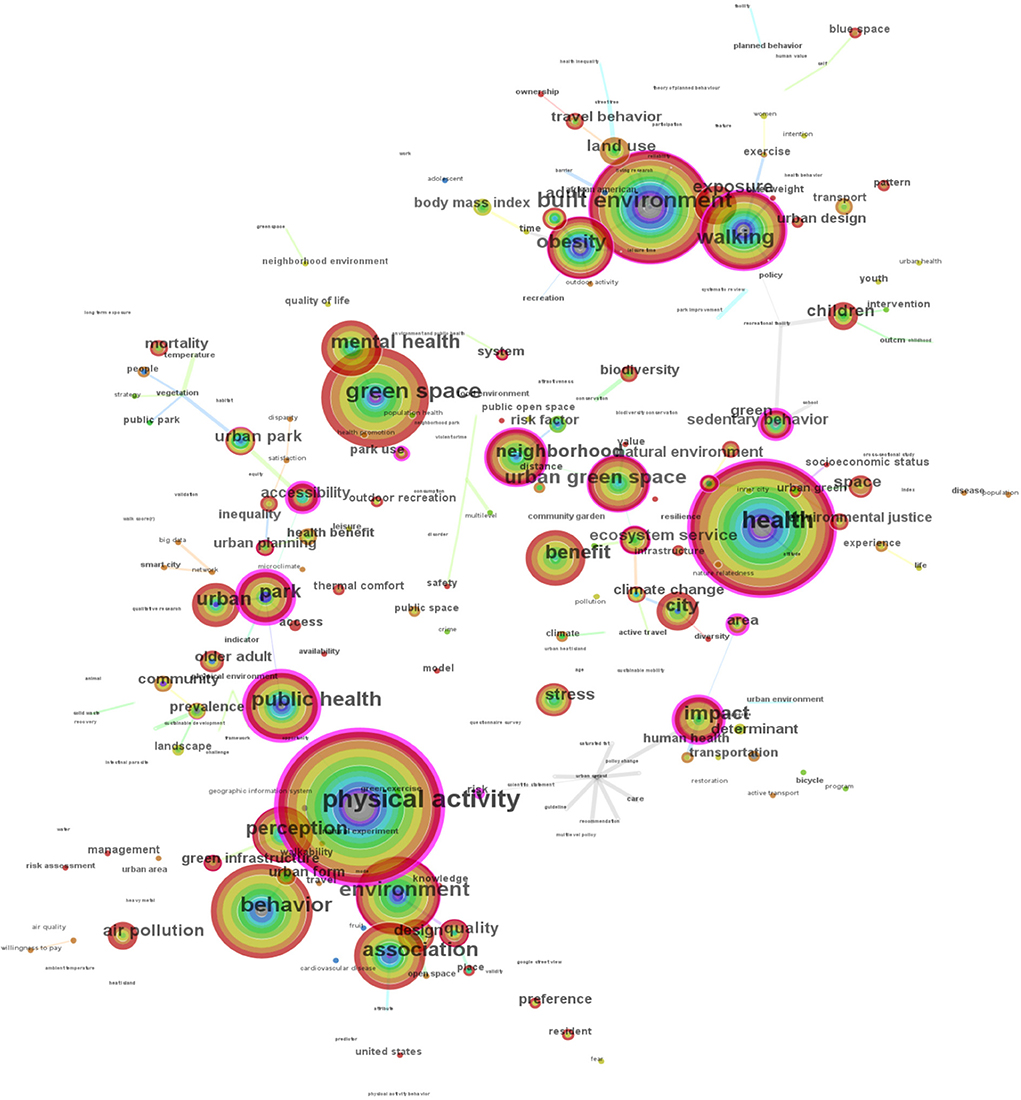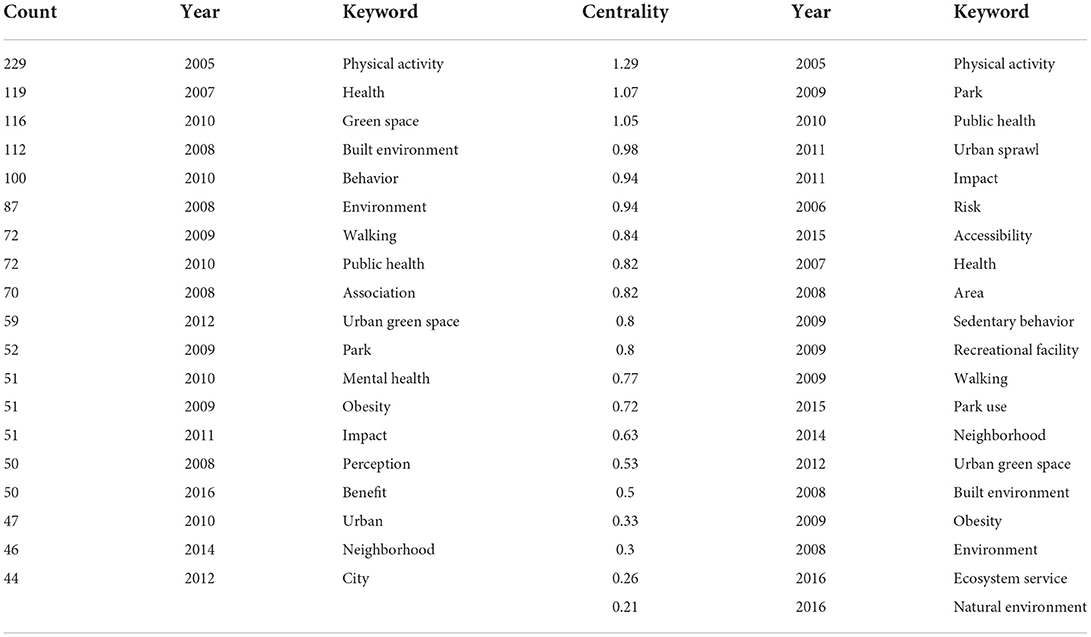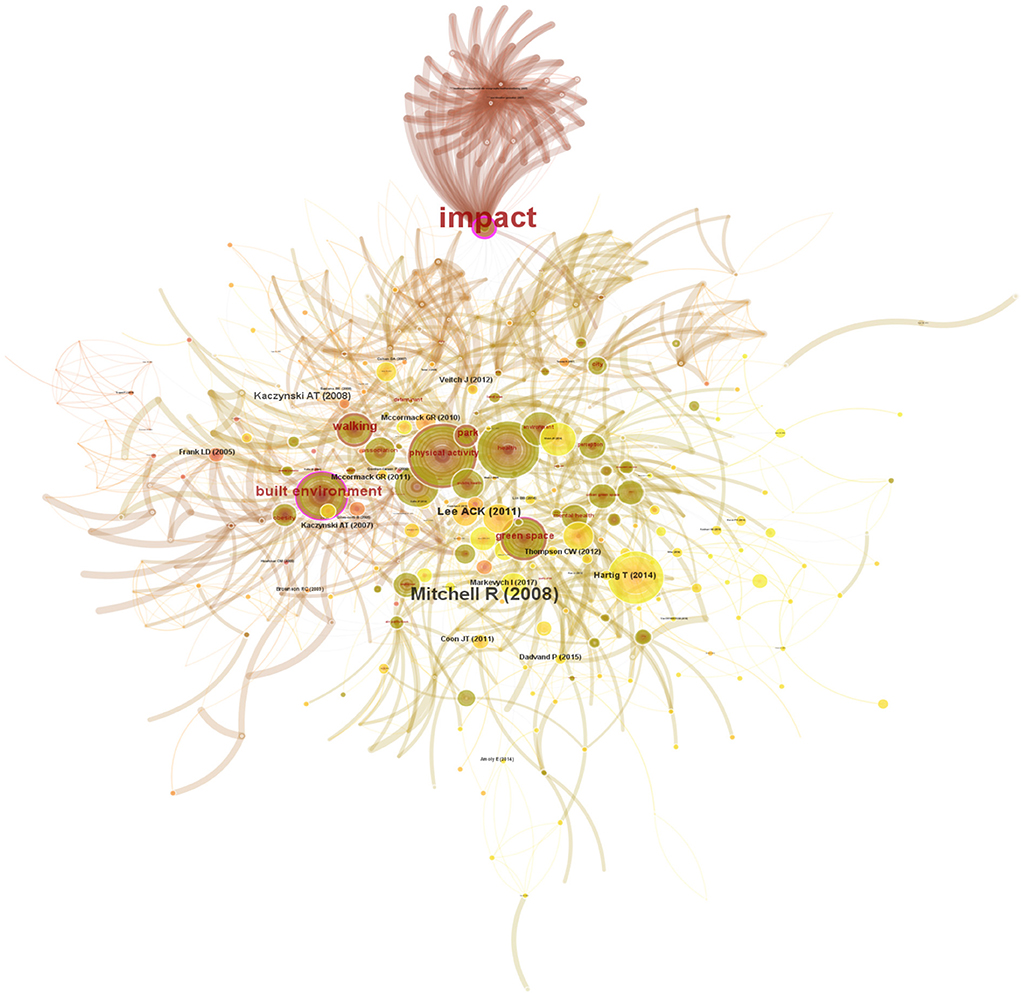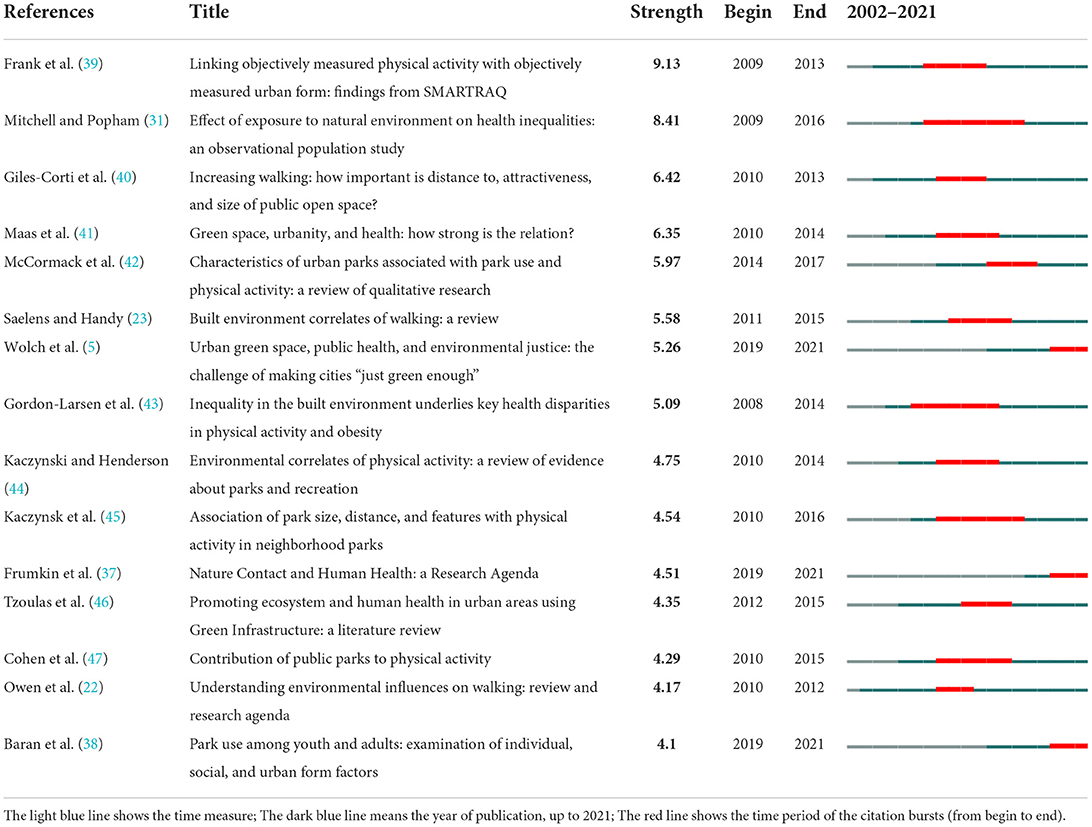- 1Department of Landscape Architecture, School of Architecture, Southwest Jiaotong University, Chengdu, China
- 2School of Architecture and Urban Planning, Chongqing University, Chongqing, China
Urban green space can supply a range of ecosystem services and general health benefits for people. This paper reviewed and analyzed 607 papers related to urban green space and health behaviors from 2002 to 2021 in the Web of Science core collection by using Citespace 6.1.R2 software. The scientifically bibliometric analysis and visual analysis were conducted to analyze the basic characteristics, literature co-citation analysis, research hotspots, and frontier trends. The findings show that 11 co-citation clusters indicate the research intellectual base. Also, 19 main keywords with a high frequency and 20 main keywords with a high centrality were extracted. Burst detection analysis reveals three research frontier trends: the correlation between urban green space and health behavior; the driving and impact factors; and the study of environmental justice and social equity. This paper aims to systematically review the progress and basic situation of urban green spaces and health behaviors research around the world, which helps to gain a comprehensive understanding of this field, as well as provide value and references for subsequent research.
Introduction
Globally, there is no such universal definition of urban green space. Its definition varies according to context or geographic range. Generally, urban green space (UGS) includes parks, gardens, street greenery, wetlands, community green spaces, natural woodland, etc., which is recognized as the optimized mechanism for human living environments and life quality (1, 2). UGS can deliver varieties of ecosystem services and general health benefits for people, especially for women and the old (3, 4), by encouraging various physical activity behaviors and nature contact (5–8).
World Health Organization (9) (WHO) defined “health” as “a state of complete physical, mental and social wellbeing, not merely the absence of disease or infirmity”. Currently, the increasing frequency of global public health events, such as COVID-19 (confirmed 504.4 million by April 20, 2022), and the huge burden of disease, such as there were 13.1% age-standardized prevalence of obesity among adults in 2016 (10), has gained more international attention and academic concern. A number of studies have explored and explained the relationship between UGS and human health behavior (HB), concerning physical and mental health. Most studies proved that UGS has a positive influence on HB. For example, a previous WHO report states that UGS can positively affect physical activity and mental health (11). More specifically, greater use and coverage of UGS in residential communities can improve behavioral development, reduce rate of Attention of Deficit Hyperactivity Disorder in children (12), help restorative psychological effects (13), and reduce the feelings of loneliness (14). Also, streetscape greenery positively affects old adults' walking propensity and travel ability (15–17). Urban wildscapes are positively associated with adults' perceived restoration, stress, and mental health (18). Besides, the complex UGS system (i.e., the horizontal, vertical greenery, and proximity of green levels) could reduce residents' obesity (19).
Yet, existing reviews mainly focus on the factors that affect the relationship between UGS and HB, such as the exposure to UGS air pollution and health (20), certain ecosystem services and health (21), UGS and walking (22, 23). The literature on integrating research of UGS and HB in the review article group remains limited. A scientifically bibliometric analysis of the general UGS and HB research is required. In this paper, the publications related to UGS and HB from 2002 to 2021 were analyzed by using Citespace 6.1.R2 software, while contributing to the ongoing discussion. The remainder of this paper is organized as follows. Section Materials and methods presents the methodology of this study. Section Results provides a coherent knowledge base regarding the basic characteristics (distribution of years, journals, disciplines, areas, countries, and institutions), literature co-citation analysis, research hotspots, and frontier trends combined with the visual knowledge maps. In conclusion, implications and limitations, and future development prospects are discussed in section Discussion. The main findings in this paper were concluded in section Conclusion. This study aims to systematically review the progress and basic situation of UGS and HB research around the world, in order to provide a scientific reference for the related research.
Materials and methods
Data collection
A preliminary search in the Web of Science Core Collection (WoSCC) database was conducted to select the keywords. Then, the retrieval type was: (TS = “urban green space” AND “health behavior”) OR (TS = “urban park” AND “health behavior”) OR (TS = “urban green infrastructure” AND “health behavior”) OR (TS = “urban green” AND “health behavior”), only concerning the original research article and review. Timespan (almost 20 years): 2002-01-01−2021-12-31 (since there is no product in 2001), language = English. Search time was July 19, 2022. Finally, 607 publications were obtained, including 553 articles and 54 review articles, according to relevance and then removed the duplications.
Methods
Citespace (Citation Space) is a software that combines scientometric analysis and visual analysis, which can present the structure, rules, and distribution of scientific knowledge. Also known as the “Mapping Knowledge Domains, MKD” (24, 25). Six hundred and seven references were imported into Citespace 6.1.R2, and then were further analyzed regarding the publication output and journal distribution, the development of disciplines and research areas, distribution by countries and institutions, co-citation analysis, research hotspots, and frontiers analysis, by setting and modulating the relevant parameters (see Figure 1). Figure 1 shows that the process of research methodology in this paper.
Results
Profile of publication
Publication output and journal distribution
As can be seen from Figure 2, literature publication generally shows a growing trend from 2002 to 2021, consisting of two periods: a slow growth period and a rapid growth period. First, from 2002 to 2013, it showed a slow growth trend, during which there were three times of decline (2006–2007; 2010–2011; and 2012–2013). During this period, only 83 articles were published, accounting for 13.67%. But in the period of rapid growth (from 2014 to 2021), there were 524 publications, increasing by as much as 8-fold compared to the first period. This may be related to people's increasingly strong pursuit of health awareness and outcomes.
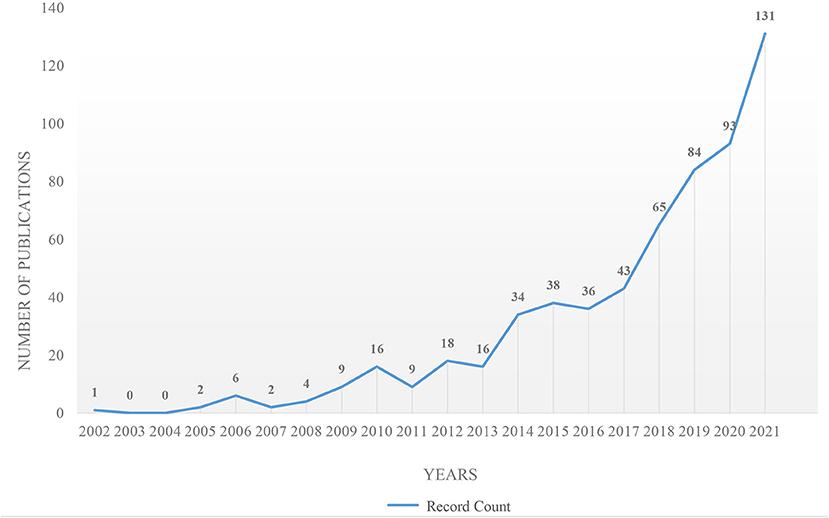
Figure 2. Literature distribution by years concerning the study of urban green space and health behaviors. Graphical representation based on WOS Core Collection search on July 19th, 2022.
Regarding the study of UGS and HB, the papers were mainly published in journals concerning public, environmental & occupational health, environmental research, and urban studies. Table 1 shows the main productive source publications. International Journal of Environmental Research and Public Health, Urban Forestry Urban Greening, and Landscape and Urban Planning are the top three productive journals. Among these, Science of the Total Environment has the highest impact factor (10.753). Articles were published in these ten journals that accounted for about 32% of the total.
Development of disciplines and research areas
Although the amount of literature obtained from the retrieval results is small, the studies involve 93 disciplines in total. There are six categories with articles over 40: Public Environmental Occupational Health (194), Environmental Sciences (148), Environmental Studies (116), Urban Studies (82), Green Sustainable Science Technology (43), and Geography (40), respectively. Moreover, the research field involves 73 research areas, of which, the area of Environmental Sciences Ecology accounts for the highest occupation (247 articles).
Distribution by countries and institutions
The publications are from 74 countries and regions in the world. Table 2 presents the top ten most productive countries. Although the United States had the highest number of publications (193), it ranked fifth (0.18) in terms of betweenness centrality value, as the same as China (0.18). Australia ranked fourth regarding the record count (66). Its betweenness centrality value was the highest (0.37), indicating that Australia is in the most critical position in the cooperative network. Italy (0.34), England (0.22) and the Netherlands (0.21) followed. Also, from Figure 3, we can see that European countries form the most important network of cooperative relationships. In addition, China is the only Asian country in the top 10 countries/regions. “the National Natural Science Foundation Of China” ranked fourth among the top scientific research funding institutions. This may be related to the fact that the Communist Party officially put forward the “consciousness of advocating a community with a shared future for mankind” at its 18th National Congress in 2012. The mainstreaming of this consciousness has led scholars to pay more attention to human health.
A cooperation network of institutions produced 120 nodes (Figure 4), indicating the authors are from 120 research institutions. The top three productive institutions are the University of Hong Kong (14), the University of Exeter (14), and the University of Melbourne (11). The top 50 are dominated by the United States (15), Europe (13), Asia (9), Australia (6), Canada (3), New Zealand (3), and Brazil (1). It can be seen that the related studies are almost concentrated in European countries, North America, Australia, and Asia. A few in Latin America. The results are evenly distributed in space. Figure 4 also shows that a relatively close cooperative network has been formed among various academic institutions.
Analysis of reference co-citation
A and B are the co-cited relationship when papers A and B appear together in the reference list of a third cited paper (25). Similar studies can be aggregated by literature co-citation analysis to form major research areas, which shape the citation network that can trace the development context forward and explore the research frontier backward, as well as form the knowledge base of the specific research field. In all, 607 publications were analyzed in Citespace. Eleven clusters were extracted by using the clustering algorithm. They were labeled by the first term from the LLR (log-likelihood ratio, p-level) algorithm, numbered from #0 to #10 (Table 3). In Table 3, the silhouette value of each cluster is >0.7, indicating that the clustering reliability is very high. It is worth mentioning that the larger the silhouette value, the higher the similarity of the cluster members. Among the 11 clusters, the average year of nine clusters was 2015 or later, indicating that most of the clusters (related research) are relatively new. The mean year of publication in Cluster #6 and Cluster #9 was 2020, named “COVID-19” and “utilizing big data”, which is related to COVID-19 pandemic in 2019, and the increasing use of internet big data. Moreover, 11 clusters actually reflect the intellectual basis of the UGS and HB research. The largest top three clusters are “human health”, “park use”, and “residents' perception”, showing that the main research base is under the human health, park use, and residents' perception research fields.
The co-citation analysis map was achieved (Figure 5). In Figure 5, different colors represent different clusters. Nodes represent different publications, and lines represent network relationships between the publications. Figure 5 shows the complex integration among 11 clusters, indicating that they are not independent studies under 11 research fields, but also cross-over studies.
Besides, the top ten highly-cited publications in the sample range are listed in Table 4. The paper “Nature and Health” published by Hartig et al. (13) is significant since it has the highest citation frequency (66). Besides, regarding the frequency higher than 20, there are four articles in Cluster #1, two each in Cluster #3 and Cluster #4, and one each in Cluster #0 and Cluster #2.
Cluster #0: Human health
Cluster #0 is the largest cluster (86 members), appearing dark green in Figure 5. Cluster #0 was formed from 2008 to 2019, and the average year of publication is 2017, which means this is a new cluster. It quickly became the largest cluster in a very short period of time. This cluster focused on human health, highlighting the key role of the urban green environment in human welfare.
There are four articles that have a citation frequency higher than 10 in this cluster. Moreover, a paper by James et al. (29), “A Review of the Health Benefits of Greenness” had the highest citation count in Cluster #0 (34). It found strong evidence for a positive correlation between greenness and physical activity. Besides, the article “Advantages of public green spaces in enhancing population health” by Sugiyama et al. (35) was the most active paper, since it cited 26 papers from Cluster #0. This paper focuses on the important relationship between public green spaces and health benefits, as well as three advantages of using public green spaces as a health promotion measure.
Cluster #1: Park use
Cluster #1 was labeled as “park use” with 78 members. The publication years of this cluster are from 2006 to 2019 (Mean year = 2015). The citation counts of eleven papers exceed 10. This cluster mainly focuses on the studies on how the general or the specific characteristics of parks could affect their usage for residents.
The article by Wolch et al. (5), has the highest citation count, also the third most cited article among 607 papers. It emphasizes the key role of urban green space in public health. It also explained the paradoxical nature of urban green space strategies, whereby creating new green spaces to make neighborhoods healthier (e.g., environmental justice issues), is accompanied by an increase in housing costs.
Furthermore, Sugiyama et al. (35) is still the most active literature that cited 17 papers in Cluster #1. And then the paper “The associations between park environments and park use in southern US communities” by Banda et al. (36), cited 15 papers in Cluster #1.
Research hotspots analysis
Keywords co-occurrence analysis refers to the co-occurrence relationship between two terms when they appear jointly in one paper. The higher the frequency of co-occurrence, the stronger the relationship between the two keywords. Through the co-occurrence analysis of keywords, hot topics in a given field can be analyzed. Then, a co-occurrence analysis map of keywords was obtained (Figure 6). There are 216 nodes (i.e., 216 critical keywords), and 105 links (density = 0.0045).
In Figure 6, the circle node represents the frequency. The higher the frequency, the larger the circle. The purple nodes in the outer ring indicate the highest betweenness centrality. The largest circle node is “physical activity”, with a count of 229, as well as the highest betweenness centrality value of 1.29. It also was the first important keyword appearing in 2005. Moreover, in Table 5, 19 keywords were extracted, since they had a frequency >40, showing that research on such areas has become increasingly popular. Twenty keywords were extracted and ranked by betweenness centrality, indicating that studies on such fields have been a research focus. According to Table 5 and Figure 6, we can see that the keywords mainly involve three research objects: (1) Different scales of UGS, like urban parks, neighborhood parks, recreational facilities, and so on; (2) Different health behaviors and outcomes, such as walking, sedentary behavior, obesity, and mental health; (3) The impact factors, e.g., accessibility, impact, risk.
Research frontiers analysis
Burst detection can capture nodes with great frequency changes in a certain period of time. Such mutation information can reflect the rise of a research theme, which is often used to do cutting-edge analysis. A map of burst detection of emerging terms and references was achieved (Figure 7). There are 504 nodes and 3,364 links (density = 0.0265). Light yellow nodes represent the reference, and dark yellow nodes represent the terms, in proportion to the degree of betweenness centrality. So, the term “built environment” and the paper by Mitchell and Popham (31) have the highest centrality value.
A total of 9 keywords were extracted (Table 6). As mentioned above, “physical activity” is the first key term that is confirmed again here. Moreover, “built environment” has the strongest strength of citation bursts (8.7), and its influence lasted from 2008 to 2013. However, no important keywords with strong citation burst were added after 2018. Furthermore, the top nine keywords with the strongest citation burst also reflect the research frontiers related to UGS and HB, including driving factors (e.g., built environment, risk factors, public parks, intervention); and the dimensions of health (e.g., physical activity, walking, obesity).
Moreover, Table 7 shows the top 15 references with the strongest citation bursts in the WoSCC database from 2002 to 2021. Among them, the strength of the citation bursts started from 2008 to 2021. From 2019 to 2021, there are three papers with high strength in the citation bursts: Wolch et al. (5); Frumkin et al. (37); and Baran et al. (38), indicating that they are nearly 3 years of cutting-edge research.
The top 15 articles further reveal the research frontiers, integrating with the other publications with strong citation bursts. Hence, there are three research frontiers regarding the study of UGS and HB in the nearly two decades: (1) the relationship between UGS and HB; (2) the influence factors; (3) environmental justice and social equity.
Discussion
Implications and limitations
The findings show that the number of publications increased from 2002 to 2021. And it has increased significantly since 2014, which is closely related to the global organizations supporting national efforts with much-sophisticated assistance. For instance, Global Action Plan was published in 2014 (34), and the 17 United Nations Sustainable Development Goals (SDG) were adopted in 2015. More specifically, SDG 3 “good health and well-being” advocates for all countries to guarantee and improve people's health. Also, SDG 11.7 aims to achieve the following: “By 2030, provide universal access to safe, inclusive and accessible, green and public spaces, in particular for women and children, older persons and persons with disabilities” (48). Furthermore, the most important jump happens from 2019 to 2021, which is a period facing a global public health crisis COVID-19, that may indicate a motivation for academia to focus on health behaviors research.
Besides, most published journals belong to the medical category (e.g., “public, environmental & occupational health”, “medicine”, “general & internal”) and the environmental sciences and ecology category (e.g., “environmental sciences”, “urban studies”). Herewith, the natural sciences are dominant in the research of UGS and HB. There are few studies related to social science. A discipline that intersects the natural and social sciences is involved, such as psychology. So, in future research, some sociocultural aspects of UGS, such as aesthetics and historical culture, should be considered for their impact on human health behavior.
Eleven clusters extracted in this paper provide a knowledge base for the research areas of UGS and HB. Through in-depth analysis, some articles are highly cited (Table 4), which is also confirmed by the burst detection analysis (Figure 7). Hence, as a knowledge base, the highly cited articles in the clusters still have enough influence on the current research.
From the keyword co-occurrence analysis in Section Research hotspots analysis, three research objects demonstrate that the keywords mainly focus on the UGS types and scales, HB types and outcomes, and the influencing factors. Yet, there are few keywords related to different human groups (e.g., age, gender, socioeconomic status, race), landscape and ecological characteristics (e.g., aesthetic value, cultural services, biodiversity), and social issues (e.g., landscape equity and justice).
Although considerable research supports that UGS has a positive influence on health, the theoretical and conceptual frameworks for how UGS provides benefits to human health and wellbeing are limited (49). Besides, at present, urban green space design for human health is mostly concentrated in the field of medical and rehabilitation design, which ignores the continuity and correlation of different UGS. Many findings could provide references for urban spatial planning, landscape design, and decision-making (49, 50). Hence, the co-work of landscape architects, urban planners, and designers is essential to devote themselves and their professional knowledge and experience to the maximized and optimized planning and design of UGS concerning the health benefits, combined with scientific studies.
Yet, this paper has some limitations. First, this study only collected publications in the WoSCC database, rather than using multiple databases to collect a larger sample of studies. Also, we only select English articles for analysis. Therefore, some non-English papers will be ignored. Second, due to space limitations, some literature clusters and nodes need to be further analyzed in detail.
Future research trend
First, Plenty of studies have been conducted to explain the relationship between green space and human wellbeing. From the perspective of positive correlation, green space is beneficial to improving people's health and wellbeing (46, 47), both in physical health and mental health. For instance, the percentage of green space in a resident's living environment is positively correlated with their perceived health (41). Besides, Sugiyama et al. (51) evidenced that perceived community greenness was more strongly associated with mental health than physical health, by using a sample of 1,895 adults with physical and mental health scores in the Adelaide of Australia. Although many studies proved that nature contact and UGS may offer a range of human health benefits (13, 37, 44), there is still much evidence that remains unknown. Conversely, green space also leads to negative outcomes, such as the potential pathogenic effects of UGS. Hence, the relationship between UGS and HB is complex and interactive, which is one of the future research trends.
Second, there is comparatively little evidence proving that specific health benefits are associated with certain features of UGS, though in the huge body of literature in this research area. Understanding the impact factors of UGS on human health behaviors is a research priority and frontier, concerning both qualitative and quantitative methods. Different physical health effects and psychological benefits are linked to different characteristics of UGS, which is significant (39, 42, 52, 53). There are two typical kinds of features regarding UGS. One is the particular characteristics and attributes of UGS, referring to size, area, aesthetic characteristics, landscape quality, functional infrastructure, etc. Specifically, the certain functional infrastructure (i.e., trees, lawns, flowerbeds, and play and outdoor fitness equipment) and aesthetic factors of UGS can promote adolescents' health exercise (54, 55). Also, residents prefer to use parks with distinctive designs (45). Another one is the features related to the external environment, such as distribution, distance, and accessibility of UGS. More specifically, the accessibility and distance of UGS can affect human behavior, such as the levels of walking (40). Most studies proved that both have a positive and significant relationship with HB (22). Hence, well-planned, well-designed, and better features of UGS may lead to increased usage and physical activity (56).
Last but not least, due to the many benefits of green space to human health, when green space becomes a special or even a scarce resource, it will inevitably involve environmental and social inequity. For instance, Gordon-Larsen et al. (43) believe that inequality in the availability of UGS for lower socioeconomic status groups may lead to overweight. Recently, some studies focus on the fair access and use of UGS concerning health behaviors and outcomes, especially for different age groups (youth, adults, and old adults) (15, 38, 57), different gender groups (18, 58), people of different race/ethnicity (e.g., white, black, and Hispanic) and income groups (59). For socially disadvantaged groups, whether UGS is provided fairly or not is a vital issue in the field of social and environmental justice (60). Most scholars point out that it is necessary to rationally plan the spatial distribution of UGS, and solve the problem of inequity by supplementing enough UGS and shortening the accessible distance. However, this is a contradictory issue that creating new UGS also increases housing costs and property values (5).
Conclusion
The results show the growing number of published articles from 2002 to 2021, with the number of published papers increasing from 1 in 2002 to 131 in 2021. The publication source with the highest circulation is the International Journal of Environmental Research and Public Health. Most important articles were published in journals dealing with the environment, and public health studies. The UGS and HB studies cover a total of 93 disciplines and 73 research directions. Public Environmental & Occupational Health and Environmental Sciences are the two most important disciplines. Research is more concentrated in the natural sciences. The United States had the highest number of publications, and Australia had the highest betweenness centrality value. The most productive institutions are the University of Hong Kong and the University of Exeter. A total of 11 clusters were extracted by literature co-citation analysis. The largest cluster was “human health”. The keyword co-occurrence analysis obtained 19 words with the highest co-occurrence frequency and 20 words with the highest betweenness centrality value. Plus, “physical activity” is the most important keyword. Furthermore, the keywords mainly involve three research objects (different scales of UGS; different health behaviors and outcomes; the impact factors). In the end, there are three research frontier trends: (1) the relationship between UGS and HB; (2) the influence factors; (3) the study of environmental justice and social equity.
Data availability statement
The original contributions presented in the study are included in the article/supplementary material, further inquiries can be directed to the corresponding author/s.
Author contributions
SZ conceived and designed the study, conducted the systematic review and analyzed the data, and as well as wrote the manuscript. ZC contributed significantly to analysis and manuscript preparation. YO visualized the data and made the tables. SZ and XL reviewed and refined the paper. All authors contributed to the article and approved the submitted version.
Funding
This work was supported by the National Natural Science Foundation of China (NSFC) (Grant No. 52008345) and the Natural Science Foundation of Sichuan Province (Grant No. 2022NSFSC1108).
Acknowledgments
The authors sincerely thank all reviewers and editors for their comments and help.
Conflict of interest
The authors declare that the research was conducted in the absence of any commercial or financial relationships that could be construed as a potential conflict of interest.
Publisher's note
All claims expressed in this article are solely those of the authors and do not necessarily represent those of their affiliated organizations, or those of the publisher, the editors and the reviewers. Any product that may be evaluated in this article, or claim that may be made by its manufacturer, is not guaranteed or endorsed by the publisher.
References
1. Van den Berg AE, Maas J, Verheij RA, Groenewegen PP. Green space as a buffer between stressful life events and health. Soc Sci Med. (2010) 23:1203–10. doi: 10.1016/j.socscimed.2010.01.002
2. Van den Berg M, van Poppel M, van Kamp I, Andrusaityte S, Balseviciene B, Cirach M, et al. Visiting green space is associated with mental health and vitality: a cross-sectional study in four european cities. Health Place. (2016) 38:8–15. doi: 10.1016/j.healthplace.2016.01.003
3. Wang H, Dai X, Wu J, Wu X, Nie X. Influence of urban green open space on residents' physical activity in China. BMC Public Health. (2019) 19:1–12. doi: 10.1186/s12889-019-7416-7
4. Shen J, Li M, Wang Q, Liu R, Ji M, An R. The influence of green space on obesity in china: a systematic review. Obes Facts. (2022) 15:463–72. doi: 10.1159/000524857
5. Wolch JR, Byrne J, Newell JP. Urban green space, public health, and environmental justice : the challenge of making cities “just green enough”. Landsc Urban Plan. (2014) 125:234–44. doi: 10.1016/j.landurbplan.2014.01.017
6. Koohsari MJ, Mavoa S, Villanueva K, Sugiyama T, Badland H, Kaczynski AT, et al. Public open space, physical activity, urban design and public health: Concepts, methods and research agenda. Health Place. (2015) 33:75–82. doi: 10.1016/j.healthplace.2015.02.009
7. Zhang S, Muñoz Ramírez F. Assessing and mapping ecosystem services to support urban green infrastructure: The case of Barcelona, Spain. Cities. (2019) 92:59–70. doi: 10.1016/j.cities.2019.03.016
8. Mao Q, Wang L, Guo Q, Li Y, Liu M, Xu G. Evaluating cultural ecosystem services of urban residential green spaces from the perspective of residents' satisfaction with green space. Front Public Health. (2020) 8:1–16. doi: 10.3389/fpubh.2020.00226
9. World Health Organization. Preamble to the Constitution of the World Health Organization as adopted by the International Health Conference. New York, NY (1946). p. 19–22 Available online at: http://www.who.int/governance/eb/who_constitution_en.pdf (accessed August 9, 2022).
10. World Health Organization. World Health Statistics 2022: Monitoring Health for the SDGs, Sustainable Development Goals. Geneva (2022).
12. Amoly E, Payam D, Forns J, López-Vicente M, Basagaña X, Julvez J, et al. Green and blue spaces and behavioral development in barcelona schoolchildren : the BREATHE Project. Childrens Health. (2014) 122:1351–8. doi: 10.1289/ehp.1408215
13. Hartig T, Mitchell R, De Vries S, Frumkin H. Nature and health. Annu Rev Public Health. (2014) 35:207–28. doi: 10.1146/annurev-publhealth-032013-182443
14. Maas J, Van Dilen SM, Verheij RA, Groenewegen PP. Social contacts as a possible mechanism behind the relation between green space and health. Health Place. (2009) 15:586–95. doi: 10.1016/j.healthplace.2008.09.006
15. Yang L, Liu J, Lu Y, Ao Y, Guo Y, Huang W, et al. Global and local associations between urban greenery and travel propensity of older adults in Hong Kong. Sustain Cities Soc. (2020) 63:102442. doi: 10.1016/j.scs.2020.102442
16. Yang L, Liu J, Liang Y, Lu Y, Yang H. Spatially varying effects of street greenery on walking time of older adults. ISPRS Int J Geoinf. (2021) 10:596. doi: 10.3390/ijgi10090596
17. Yang L, Ao Y, Ke J, Lu Y, Liang Y. To walk or not to walk? Examining non-linear effects of streetscape greenery on walking propensity of older adults. J Transp Geogr. (2021) 94:103099. doi: 10.1016/j.jtrangeo.2021.103099
18. Yakinlar N, Akpinar A. How perceived sensory dimensions of urban green spaces are associated with adults' perceived restoration stress, and mental health? Urban Forest Urban Green. (2022) 72:127572. doi: 10.1016/j.ufug.2022.127572
19. Xiao Y, Zhang Y, Sun Y, Tao P, Kuang X. Does green space really matter for residents' obesity? A new perspective from baidu street view. Front Public Health. (2020) 8:1–12. doi: 10.3389/fpubh.2020.00332
20. Qiu Y, Zuo S, Yu Z, Zhan Y, Ren Y. Discovering the effects of integrated green space air regulation on human health: a bibliometric and meta-analysis. Ecol Indic. (2021) 132:108292. doi: 10.1016/j.ecolind.2021.108292
21. Yang H, Shao X, Wu M. A review on ecosystem health research: a visualization based on CiteSpace. Sustainability. (2019) 11:4908. doi: 10.3390/su11184908
22. Owen N, Humpel N, Leslie E, Bauman A, Sallis JF. Understanding environmental influences on walking: review and research agenda. Am J Prev Med. (2004) 27:67–76. doi: 10.1016/j.amepre.2004.03.006
23. Saelens BE, Handy SL. Built environment correlates of walking: a review. Med Sci Sports Exerc. (2008) 40(7 Suppl. 1):550–66. doi: 10.1249/MSS.0b013e31817c67a4
24. Chen C. CiteSpace II: detecting and visualizing emerging trends and transient patterns in scientific literature. J Am Soc Inf Sci Technol. (2004) 64:359–77. doi: 10.1002/asi.20317
25. Li J, Chen C. Citespace: Text Mining and Visualization in Scientific Literature. Beijing: Capital University of Economics and Business Press (2016).
26. Markevych I, Schoierer J, Hartig T, Chudnovsky A, Hystad P, Dzhambov AM, et al. Exploring pathways linking greenspace to health: theoretical and methodological guidance. Environ Res. (2017) 158:301–17. doi: 10.1016/j.envres.2017.06.028
27. Lee ACK, Maheswaran R. The health benefits of urban green spaces: a review of the evidence. J Public Health. (2011) 33:212–22. doi: 10.1093/pubmed/fdq068
28. Ward C, Roe J, Aspinall P, Mitchell R, Clow A, Miller D. More green space is linked to less stress in deprived communities?: Evidence from salivary cortisol patterns. Landscape and Urban Planning. (2012) 105:221–9. doi: 10.1016/j.landurbplan.2011.12.015
29. James P, Banay RF, Hart JE, Laden F. A review of the health benefits of greenness. Curr Epidemiol Rep. (2015) 2:131–42. doi: 10.1007/s40471-015-0043-7
30. Hunter RF, Christian H, Veitch J, Astell-Burt T, Hipp JA, Schipperijn J. The impact of interventions to promote physical activity in urban green space: a systematic review and recommendations for future research. Soc Sci Med. (2015) 124:246–56. doi: 10.1016/j.socscimed.2014.11.051
31. Mitchell R, Popham F. Effect of exposure to natural environment on health inequalities: an observational population study. Lancet. (2008) 372:1655–60. doi: 10.1016/S0140-6736(08)61689-X
32. Lin BB, Fuller RA, Bush R, Gaston KJ, Shanahan DF. Opportunity or orientation? Who uses urban parks and why. PLoS ONE. (2014) 9:1–7. doi: 10.1371/journal.pone.0087422
33. De Vries S, Van Dillen SM, Groenewegen PP, Spreeuwenberg P. Streetscape greenery and health: stress, social cohesion and physical activity as mediators. Soc Sci Med. (2013) 94:26–33. doi: 10.1016/j.socscimed.2013.06.030
34. World Health Organization. Global Action Plan: for the Prevention and Control of Noncommunicable Diseases 2013–2020. Geneva (2014).
35. Sugiyama T, Carver A, Koohsari MJ, Veitch J. Advantages of public green spaces in enhancing population health. Landsc Urban Plan. (2018) 178:12–7. doi: 10.1016/j.landurbplan.2018.05.019
36. Banda JA, Wilcox S, Colabianchi N, Hooker SP, Kaczynski AT, Hussey J. The associations between park environments and park use in southern US communities. J Rural Health. (2014) 30:369–78. doi: 10.1111/jrh.12071
37. Frumkin H, Bratman GN, Breslow SJ, Cochran B, Kahn Jr PH, Lawler JJ, et al. Nature contact and human health: a research agenda. Environ Health Perspect. (2017) 125:1–18. doi: 10.1289/EHP1663
38. Baran PK, Smith WR, Moore RC, Floyd MF, Bocarro JN, Cosco NG, et al. Park use among youth and adults: examination of individual, social, and urban form factors. Environ Behav. (2014) 46:768–800. doi: 10.1177/0013916512470134
39. Frank LD, Schmid TL, Sallis JF, Chapman J, Saelens BE. Linking objectively measured physical activity with objectively measured urban form: findings from SMARTRAQ. Am J Prev Med. (2005) 28(2 Suppl. 2):117–25. doi: 10.1016/j.amepre.2004.11.001
40. Giles-Corti B, Broomhall MH, Knuiman M, Collins C, Douglas K, Ng K, et al. Increasing walking: how important is distance to, attractiveness, and size of public open space?. Am J Prev Med. (2005) 28(2 Suppl. 2), 169–76. doi: 10.1016/j.amepre.2004.10.018
41. Maas J, Verheij RA, Groenewegen PP, De Vries S, Spreeuwenberg P. Green space urbanity, and health: how strong is the relation? J Epidemiol Community Health. (2006) 60:587–92. doi: 10.1136/jech.2005.043125
42. McCormack GR, Rock M, Toohey AM, Hignell D. Characteristics of urban parks associated with park use and physical activity: a review of qualitative research. Health Place. (2010) 16:712–26. doi: 10.1016/j.healthplace.2010.03.003
43. Gordon-Larsen P, Nelson MC, Page P, Popkin BM. Inequality in the built environment underlies key health disparities in physical activity and obesity. Pediatrics. (2006) 117:417–24. doi: 10.1542/peds.2005-0058
44. Kaczynski AT, Henderson KA. Environmental correlates of physical activity: a review of evidence about parks and recreation. Leis Sci. (2007) 29:315–54. doi: 10.1080/01490400701394865
45. Kaczynski AT, Potwarka LR, Saelens P BE. Association of park size, distance, and features with physical activity in neighborhood parks. Am J Public Health. (2008) 98:1451–6. doi: 10.2105/AJPH.2007.129064
46. Tzoulas K, Korpela K, Venn S, Yli-Pelkonen V, Kazmierczak A, Niemela J, et al. Promoting ecosystem and human health in urban areas using Green Infrastructure: a literature review. Landsc Urban Plan. (2007) 81:167–78. doi: 10.1016/j.landurbplan.2007.02.001
47. Cohen DA, McKenzie TL, Sehgal A, Williamson S, Golinelli D, Lurie N. Contribution of public parks to physical activity. Am J Public Health. (2007) 97:509–14. doi: 10.2105/AJPH.2005.072447
48. United Nations Department of Economic Social Affairs. Open Working Group proposal for Sustainable Development Goals. (2014). Available online at: https://sustainabledevelopment.un.org/sdgsproposal.html (accessed August 10, 2022).
49. Brymer E, Brymer EA, Duarte D, Keith P, Gert J. Conceptualizing the human health outcomes of acting in natural environments: an ecological perspective. Front Psychol. (2020) 11:1–6. doi: 10.3389/fpsyg.2020.01362
50. Chen Y, Ke X, Min M, Cheng P. Disparity in perceptions of social values for ecosystem services of urban green space: a case study in the East Lake Scenic Area, Wuhan. Front Public Health. (2020) 8:1–11. doi: 10.3389/fpubh.2020.00370
51. Sugiyama T, Leslie E, Giles-Corti B, Owen N. Associations of neighbourhood greenness with physical and mental health: do walking social coherence and local social interaction explain the relationships? J Epidemiol Community Health. (2008) 62:6–11. doi: 10.1136/jech.2007.064287
52. Bedimo-Rung AL, Mowen AJ, Cohen DA. The significance of parks to physical activity and public health: A conceptual model. Am J Prev Med. (2005) 28(2 Suppl. 2:159–68. doi: 10.1016/j.amepre.2004.10.024
53. Lee HJ, Lee DK. Do sociodemographic factors and urban green space affect mental health outcomes among the urban elderly population?. Int J Environ Res Public Health. (2019) 16:789. doi: 10.3390/ijerph16050789
54. Benton JS, Anderson J, Cotterill S, Dennis M, Lindley SJ, French DP. Evaluating the impact of improvements in urban green space on older adults' physical activity and wellbeing: Protocol for a natural experimental study. BMC Public Health. (2018) 18:1–15. doi: 10.1186/s12889-018-5812-z
55. Akpinar A. Green exercise: How are characteristics of urban green spaces associated with adolescents' physical activity and health?. Int J Environ Res Public Health. (2019) 16:1–16. doi: 10.3390/ijerph16214281
56. Veitch J, Ball K, Crawford D, Abbott GR, Salmon J. Park improvements and park activity: a natural experiment. Am J Prev Med. (2012) 42:616–9. doi: 10.1016/j.amepre.2012.02.015
57. Ding D, Sallis JF, Kerr J, Lee S, Rosenberg DE. Neighborhood environment and physical activity among youth: a review. Am J Prev Med. (2011) 41:442–55. doi: 10.1016/j.amepre.2011.06.036
58. Akpinar A. How perceived sensory dimensions of urban green spaces are associated with teenagers' perceived restoration stress, and mental health? Landsc Urban Plan. (2021) 214:104185. doi: 10.1016/j.landurbplan.2021.104185
59. Liu D, Kwan MP, Kan Z. Analysis of urban green space accessibility and distribution inequity in the City of Chicago. Urban Forest Urban Green. (2021) 59:127029. doi: 10.1016/j.ufug.2021.127029
Keywords: Citespace, knowledge mapping, bibliometric analysis, urban green spaces, health behaviors
Citation: Zhang S, Li X, Chen Z and Ouyang Y (2022) A bibliometric analysis of the study of urban green spaces and health behaviors. Front. Public Health 10:1005647. doi: 10.3389/fpubh.2022.1005647
Received: 28 July 2022; Accepted: 18 August 2022;
Published: 26 September 2022.
Edited by:
Yibin Ao, Chengdu University of Technology, ChinaReviewed by:
Mian Yang, Sichuan Tourism University, ChinaJingyu Liu, Chongqing Normal University, China
Copyright © 2022 Zhang, Li, Chen and Ouyang. This is an open-access article distributed under the terms of the Creative Commons Attribution License (CC BY). The use, distribution or reproduction in other forums is permitted, provided the original author(s) and the copyright owner(s) are credited and that the original publication in this journal is cited, in accordance with accepted academic practice. No use, distribution or reproduction is permitted which does not comply with these terms.
*Correspondence: Sining Zhang, ZSNing@swjtu.edu.cn
 Sining Zhang
Sining Zhang Xiaopeng Li1
Xiaopeng Li1 Zhanglei Chen
Zhanglei Chen Yu Ouyang
Yu Ouyang